When it comes to diving, Newfoundland is known for its shipwrecks.
And not just your average sunken boats – the only collection of World War II wrecks found in Canadian waters. If that isn’t reason enough to visit this east coast province, nature has provided another powerful argument: icebergs and incredibly clear water. Mind-boggling right?!
If you’re looking for an epic Canadian scuba diving adventure, Newfoundland is just the place. This rugged Canadian landmass screams ocean adventure.
Together with Labrador, Newfoundland forms the most eastern provinces of Canada. Every summer divers from all over the world visit this area to take a swim in the bone-chilling animal-filled water. Here, the warm southern Gulf stream meets the cold northern Labrador current creating one of the most productive fisheries in the world: the Grand Banks.

Whales, puffins and plenty of other marine life, live and migrate along Newfoundland’s 9,656 kilometers (6,000 miles) coastline in June, July, and August. These animals are joined by heaping masses of icebergs, which calve off from Greenland’s glaciers as the weather warms.
If you’ve got a healthy appetite for adventure, the water is so rich with sea life you never know whether your next animal sighting will be a glittering ctenophore or a breaching humpback.
Bell Island is the largest island in Conception Bay Newfoundland, and one of the few locations in North America directly attacked by German forces during World War II. Twice U-boats raided the island, striking four iron ore carriers and sending them to a watery grave.
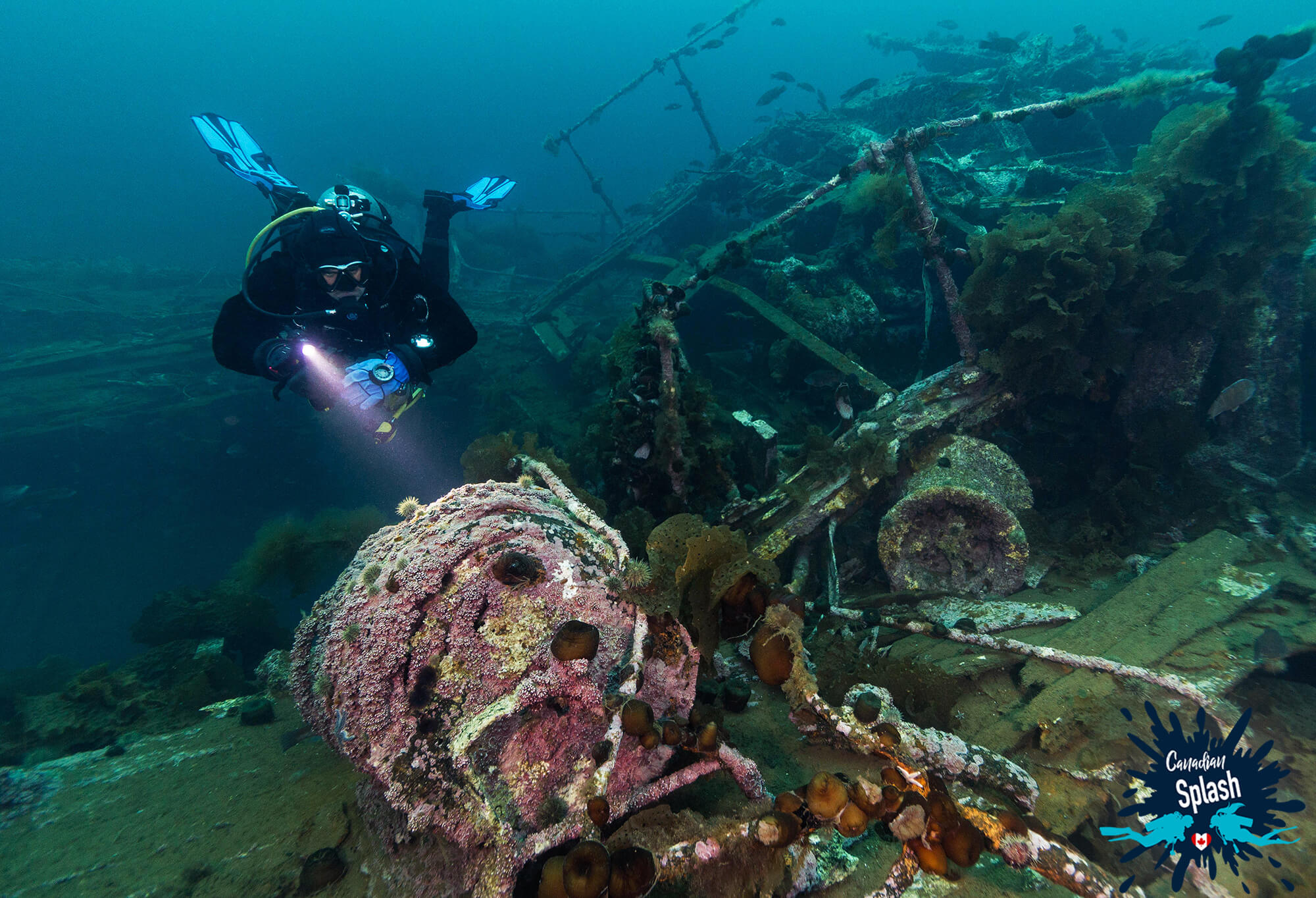
Iron ore is a valuable commodity that can be melted down and turned into steel. From 1895 to 1966 Bell Island was the site of a large iron ore mine. The mine was so extensive that the tunnels and workings extended beneath Conception Bay’s seabed creating one of the most substantial submarine-iron mines in the world.
Sometimes workers would need to go as far out as five kilometers (three miles) under the sea to work.

As one of the largest producers of iron ore in northeastern North America, most of Bell Islands bounty was shipped to Nova Scotia for the Dominion Steel and Coal Company (DOSCO). What didn’t go to DOSCO, was sent abroad, to countries such as the USA and Germany.
When World War II broke out from 1939 to 1945, Bell Island began supplying the highly sought iron ore overseas to the Allied forces for use in weapons.
To shut down their enemies productivity, in 1942, Captain Rolf Ruggeberg executed two U-boat attacks (U-513 and U-518), with direct orders from Hitler, sinking four iron ore cargo ships and killing 70 merchant mariners. The Nazi strike also hit the DOSCO iron ore loading dock with a stray torpedo.
Captain Ruggeberg was awarded two Iron Crosses, Germany’s highest military ranking during the war. What is ironic is that Germany was one of Bell Island’s biggest customers prior to the war. The crosses were likely fabricated with iron from the very same region that was attacked.
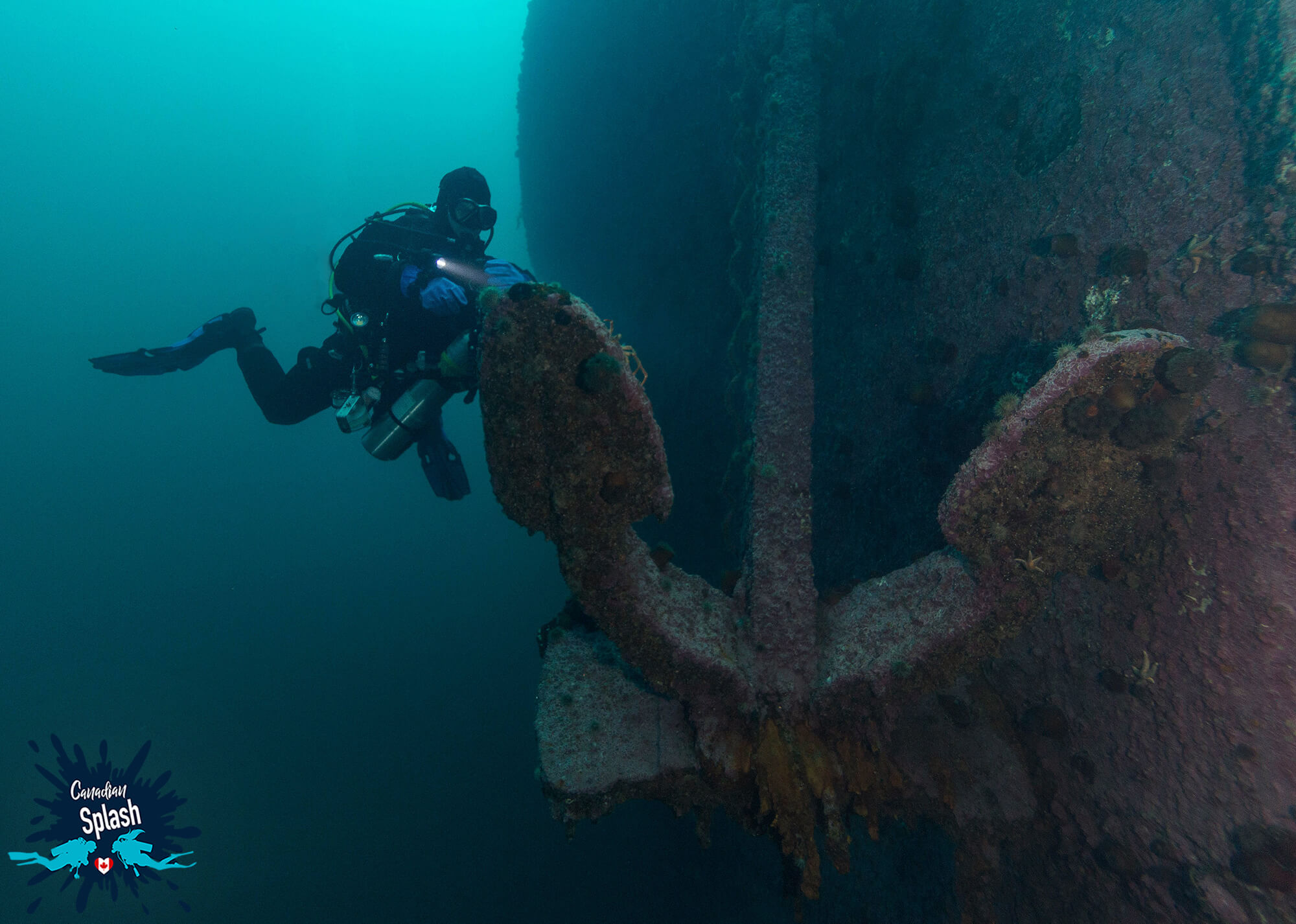
Resting at the bottom of the North Atlantic, the SS PLM-27, SS Lord Strathcona, SS Rose Castle, and SS Saganaga are the four iron ore cargo ships that met their untimely end at the hands of Captain Ruggeberg.
On September 5th, 1942 after a night of cat and mouse in Conception Bay, the German submarine U-513 honed in on the Saganaga and Lord Strathcona. Following two misfired torpedoes and a collision with the Lord Strathcona, the Saganaga was the first carrier hit on her port side.
Filled with iron ore and waiting to transport its cargo, the SS Strathcona went down in less than 30 seconds taking 48 into the water with her, 29 of whom were never recovered. As the first of Ruggeberg’s targets went down, crew members from the Lord Strathcona began abandoning ship figuring they were next.
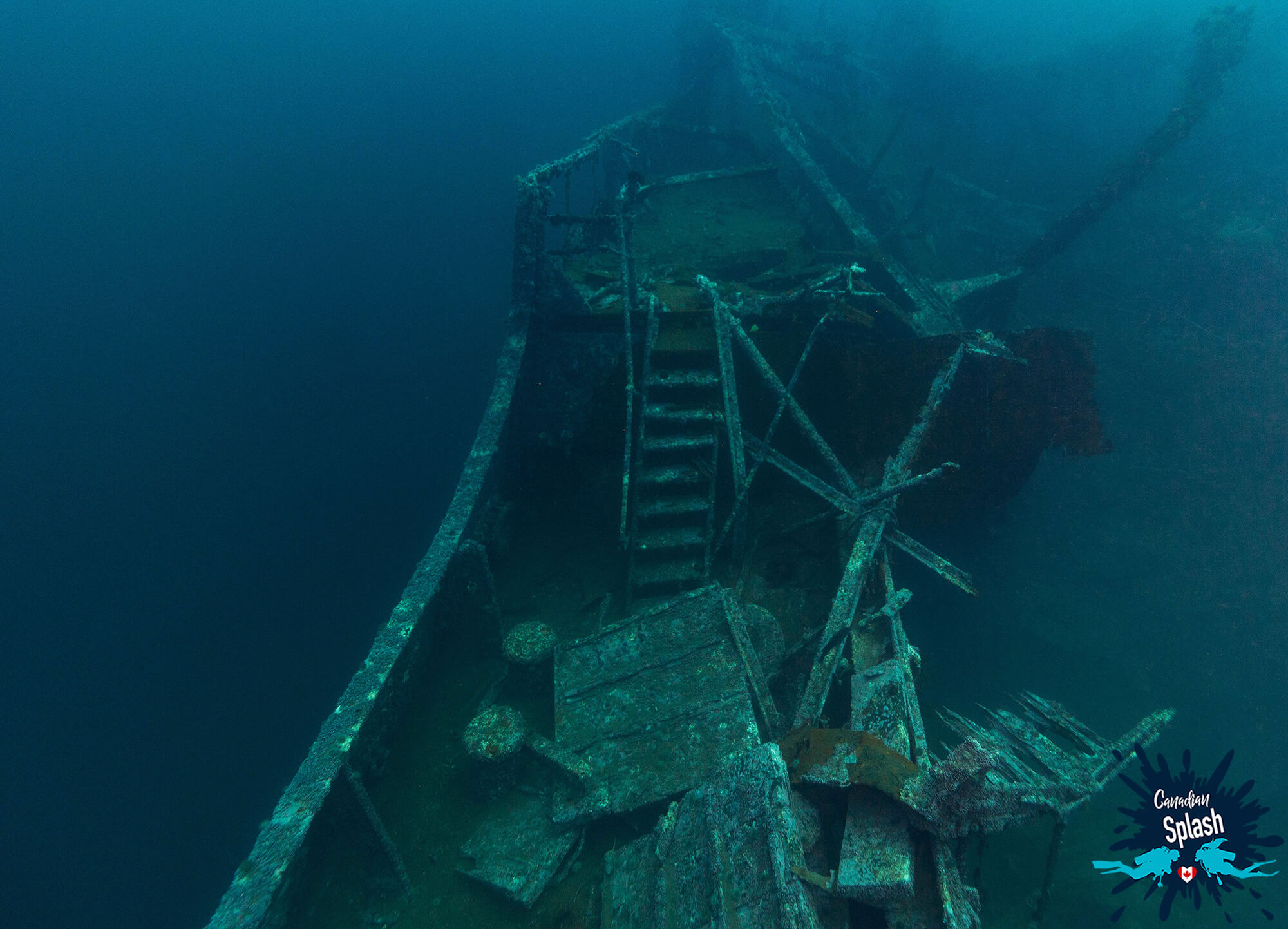
Turning on the SS Lord Strathcona, U-513 fired hitting her stern tube. The boat sank within minutes, but fortunately, all crew had abandoned the ship before the final blow, and no lives were lost.
Under damage from the initial collision with the Strathcona, Ruggeberg and the U-513, took advantage of the chaos and injured victims in the water to slip back out to sea.
Less than two months after the tragic sinking of the SS Saganaga and SS Lord Strathcona, Captain Ruggeberg and the Germans returned to Conception Bay, this time in U-518 for another round of sabotage.
While lurking around Bell Island the morning of November 2nd, 1942, the U-518 attempted to strike a coal boat, the “Anna T” missed and hit the Scotia Pier. This “accidental” event became the first and only enemy strike on a North American shore during the Second World War.
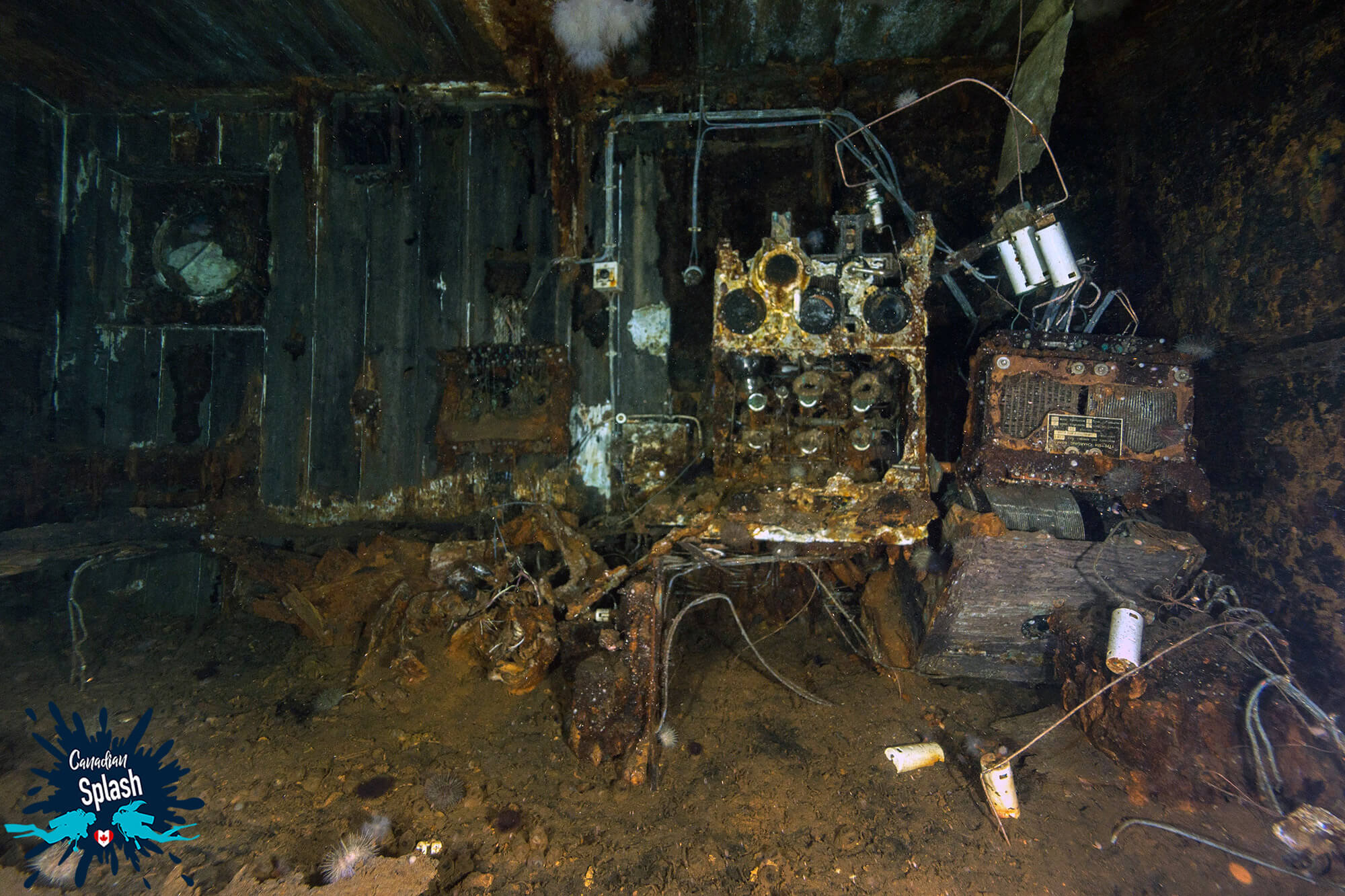
Shortly after hitting the Scotia Pier, U-518 then turned its weapons on the SS Rose Castle. The U-boat fired two torpedoes and the anchored vessel, sinking it in less than 90 seconds and killing 28 men.
The SS PLM-27 (Paris-Marseille-Lyon) was operated under the Free French Forces during World War II. Being a Free French vessel, the PLM-27 carried a multinational crew of French, Vietnamese, Egyptian and other French colonials. Following the sinking of the Rose Castle, the Germans turned to the PLM-27 torpedoing her midship on the port side. Twelve crew members lost their lives in this sinking and survivors we picked up ashore a few hundred yards away on Bell Island.
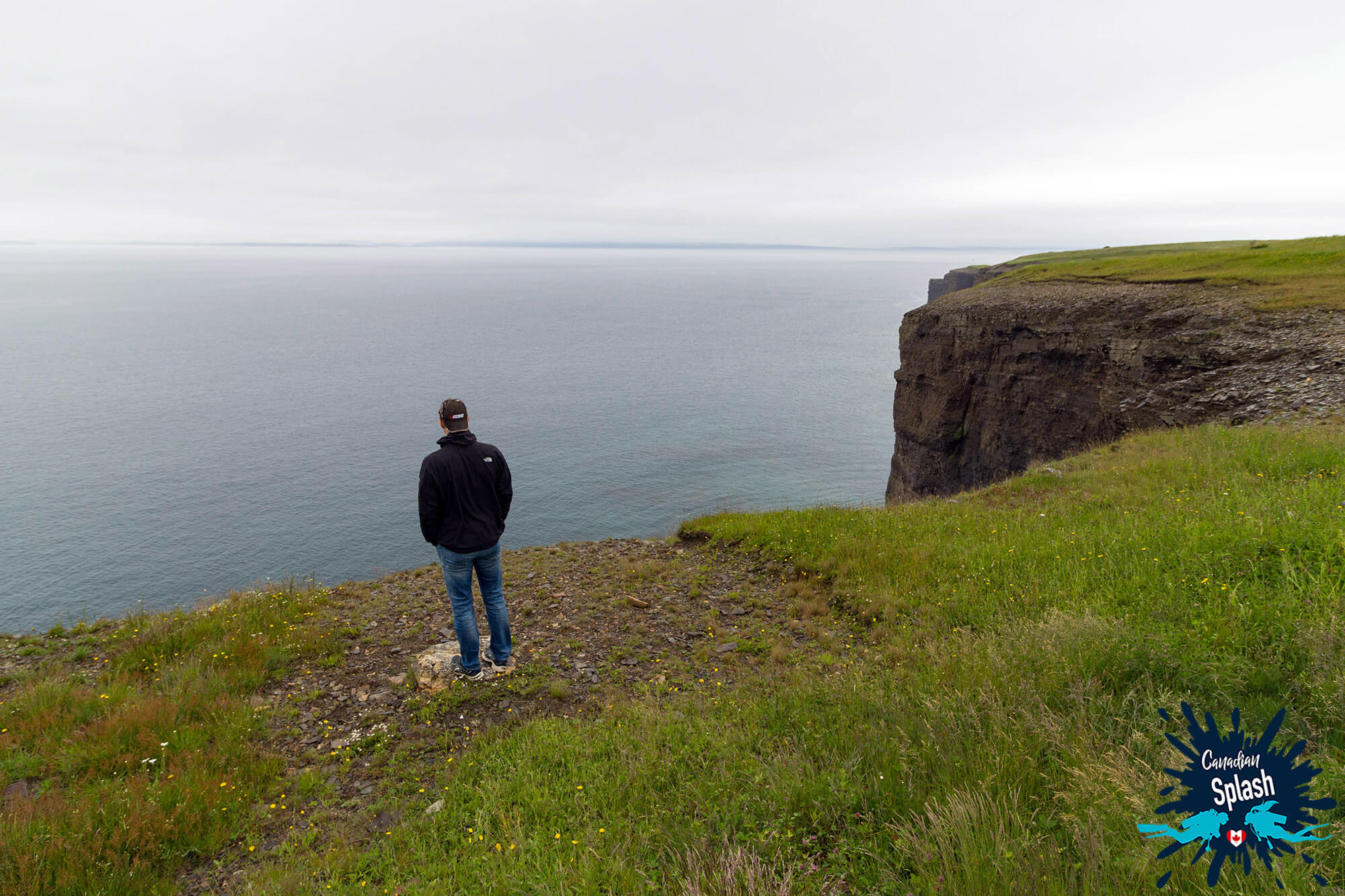
A five-day wreckspedition in Newfoundland was a much-anticipated dive trip for Joey and I. We’d heard tales of the raw beauty of Bell Island diving and wanted to see for ourselves what all the hype was about.
As seasoned divers who spent many years underwater in Nova Scotia and New Brunswick, diving on the east coast of Canada has become familiar territory. But in spite of our familiarity with the North Atlantic ocean, from the moment we arrived in Newfoundland, we could tell, diving here was going to be nothing like we’d imagined.
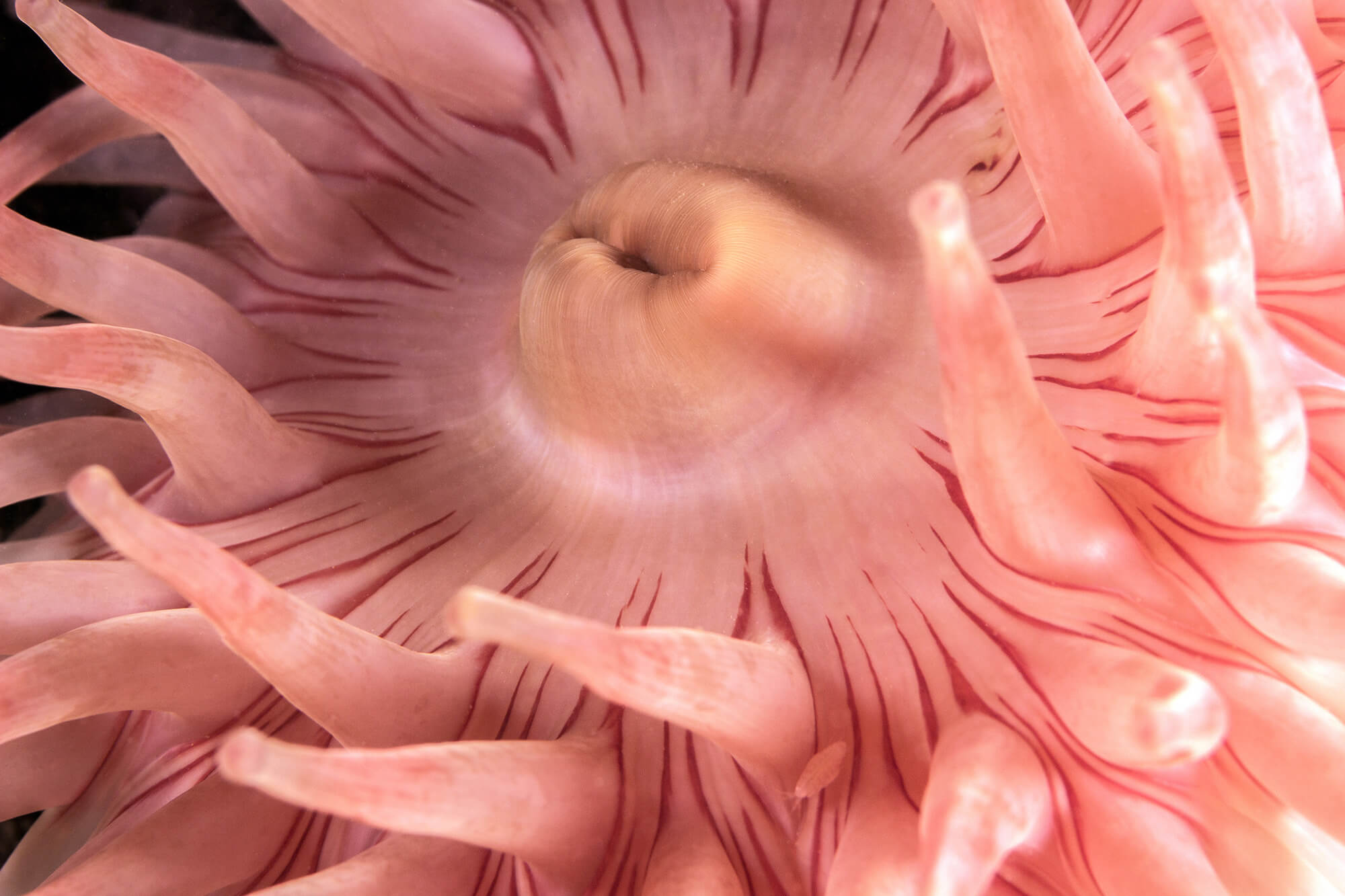
For More Information on Scuba Diving in the Province of New Brunswick:
Take a look at some of our dive write-ups on Scuba Diving the Large Tidal Whirlpool on Deer Island and Shore Diving the Cold Murky Water Around Saint John.
We found some of the clearest waters off this coastline. It was so clear it made me want to drink it. And the colors! Newfoundland had splashes of colorful animals that rivaled a Picasso masterpiece.
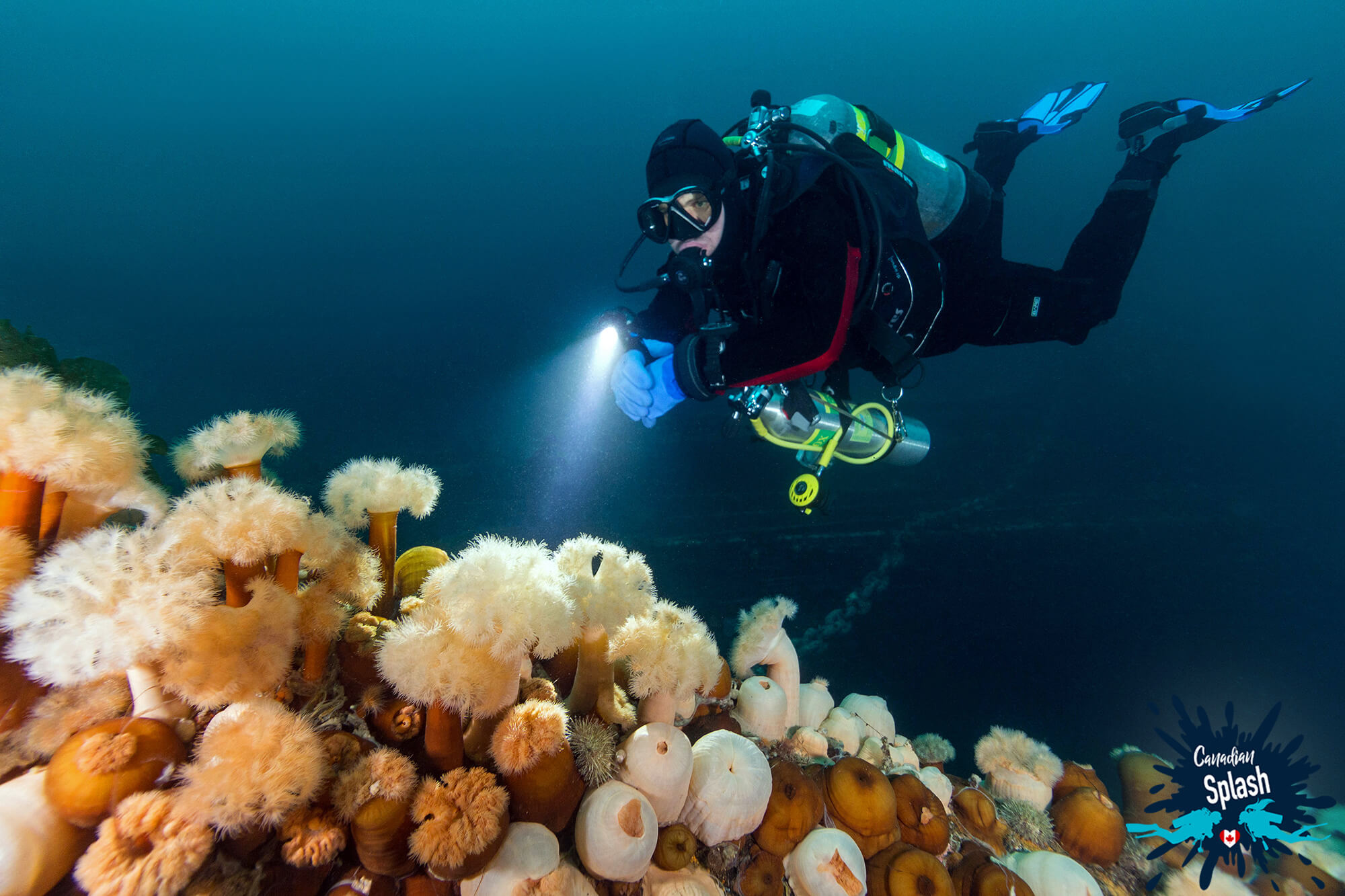
On our first day of diving, we explored the PLM-27 and Saganaga.
It took about an hour’s boat ride to make our way to the Bell Island shipwreck site. After a vivid and impeccably funny dive briefing, complete with a video introduction and 3D map, we began assembling our dive kits.
Encased in a drysuit and swamped with an unimaginable amount of gear I edged towards the rear of the boat and did one whopping stride into the calm ocean. SPLASH!
Upon initial impact, I gasped. The water was so cold it stung my face. It felt like a hundred little needles were being stabbed into my exposed skin. Once I’d gotten over the initial shock I began preparing for the descent.
We followed the anchor line down 16 meters (50 feet) passing ctenophores and jellyfish suspended in the water column. As we landed on the shallowest of the four shipwrecks, I got my first taste of the history we would be diving into over the next five days.
Thanks to its relatively shallow depth in comparison to the other vessels, the PLM-27 provided unbelievable photo opportunities and the longest bottom time.
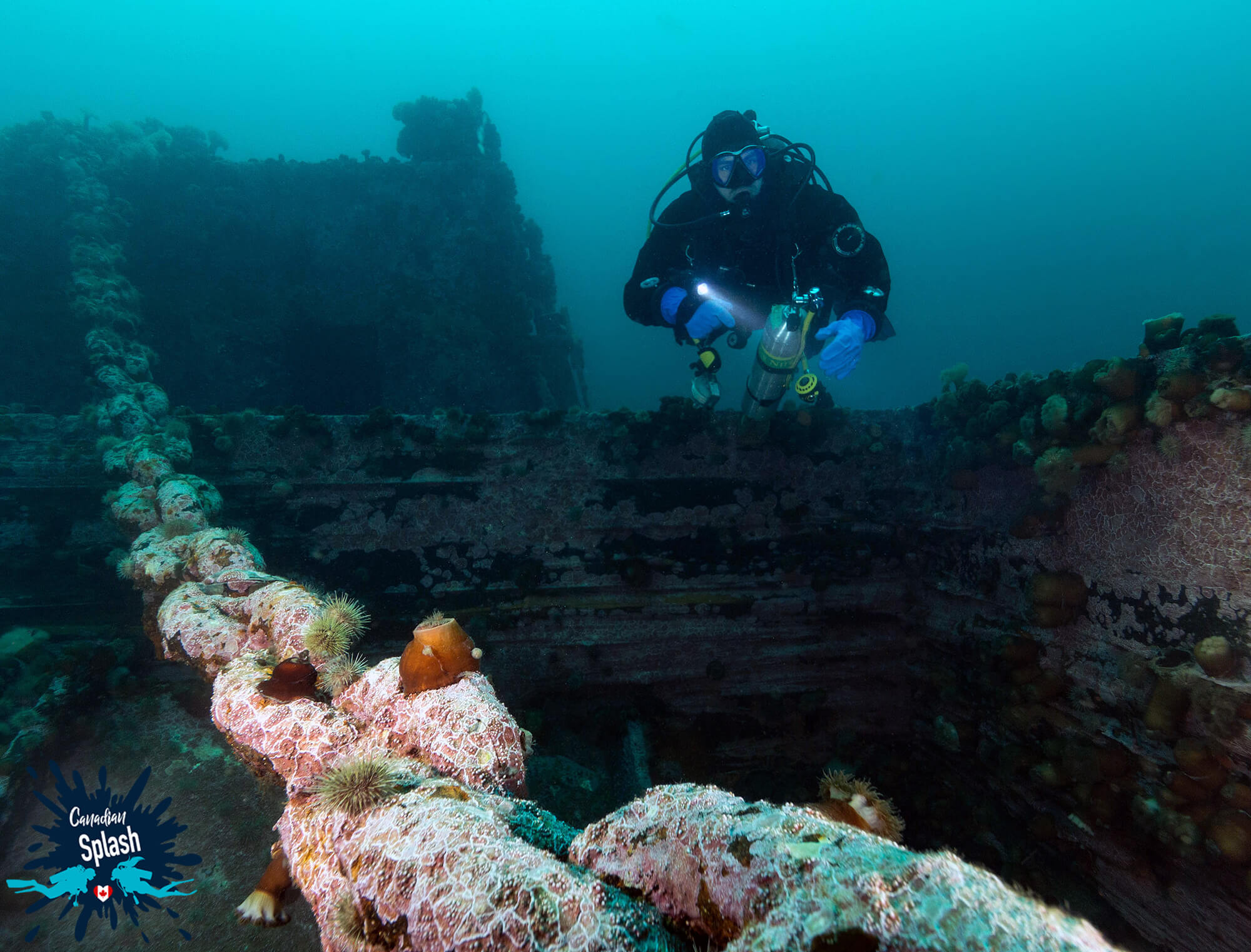
A first glance showed compartments, riggings, metal structures, and walkways into the ship. There was also tonnes of lost debris scattered willy-nilly from the sinking. And everything seemed to be coated in either soft frilly plumose anemones or bright Barbie pink encrusting algae. It didn’t take a genius to figure out that a diver could spend hours scouring the midsection alone.
We circled the middle region of the boat, looking at things of interest and then headed towards the ship’s rear end. The stern was my favorite area to explore. Not only was the railings and metal frame picturesque in the dazzle of sunlight, but we could also see and swim around the gigantic intact propeller loaded in sea stars.
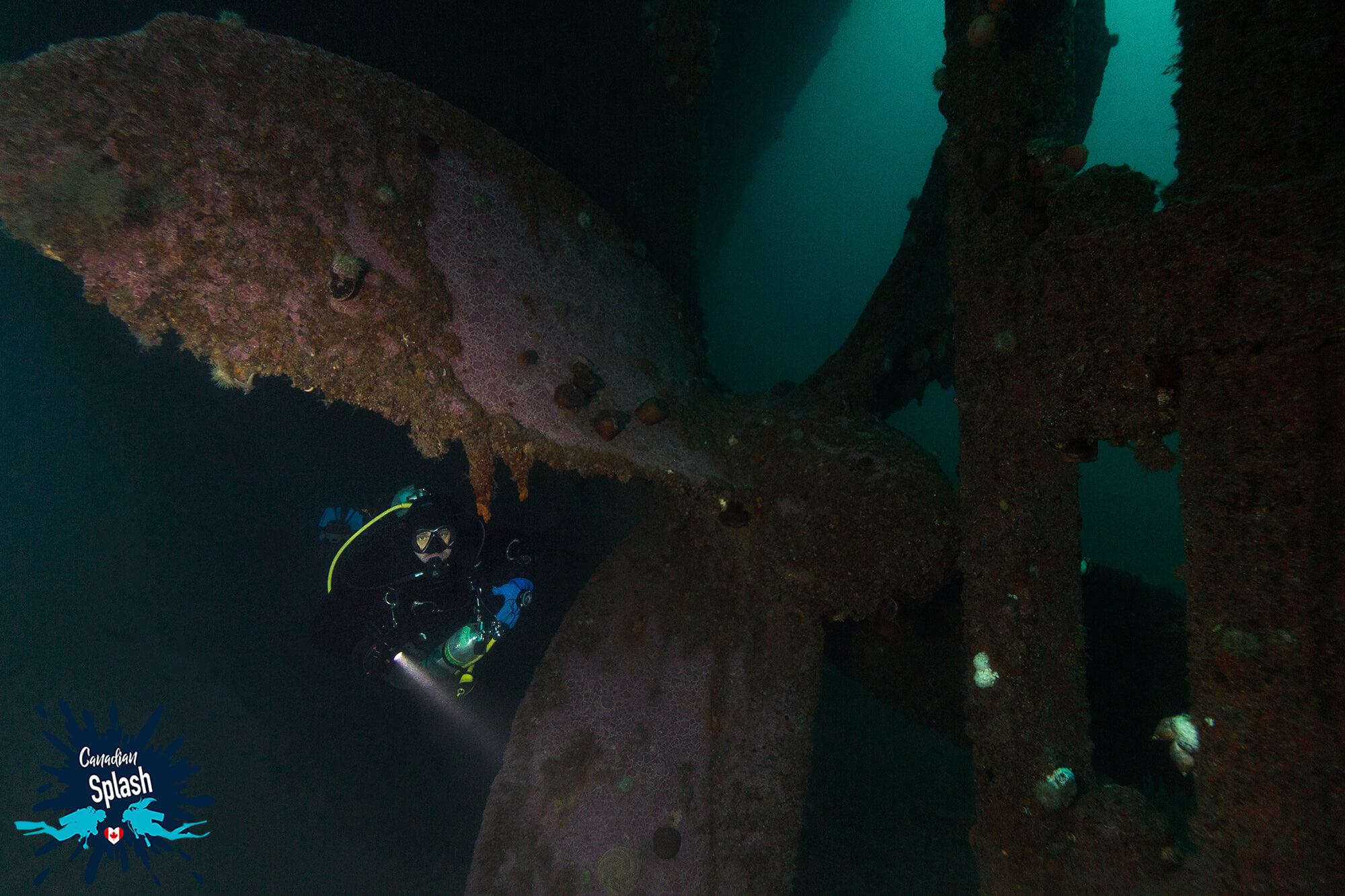

After a dive on the PLM-27 and surface interval, we were back in the water a few kilometers away at the Saganaga shipwreck site.
The Saganaga is the second shallowest of the four Bell Island wrecks. With great swim-throughs and an overwhelming amount of sea anemones draping every inch of the metal frame, this playground is a surprise and delight to all divers.
Descending towards the bottom by means of the anchor line, the Saganaga came into view.
Even at 18 meters (60 feet) deep, the sun lite up the boat’s superstructure, adding color and texture to everything below. We were promised plumose anemones and, oh baby; we sure got them. Left, right and center the shipwreck was covered in a riot of these filter-feeding animals, with every available space filled with something living.
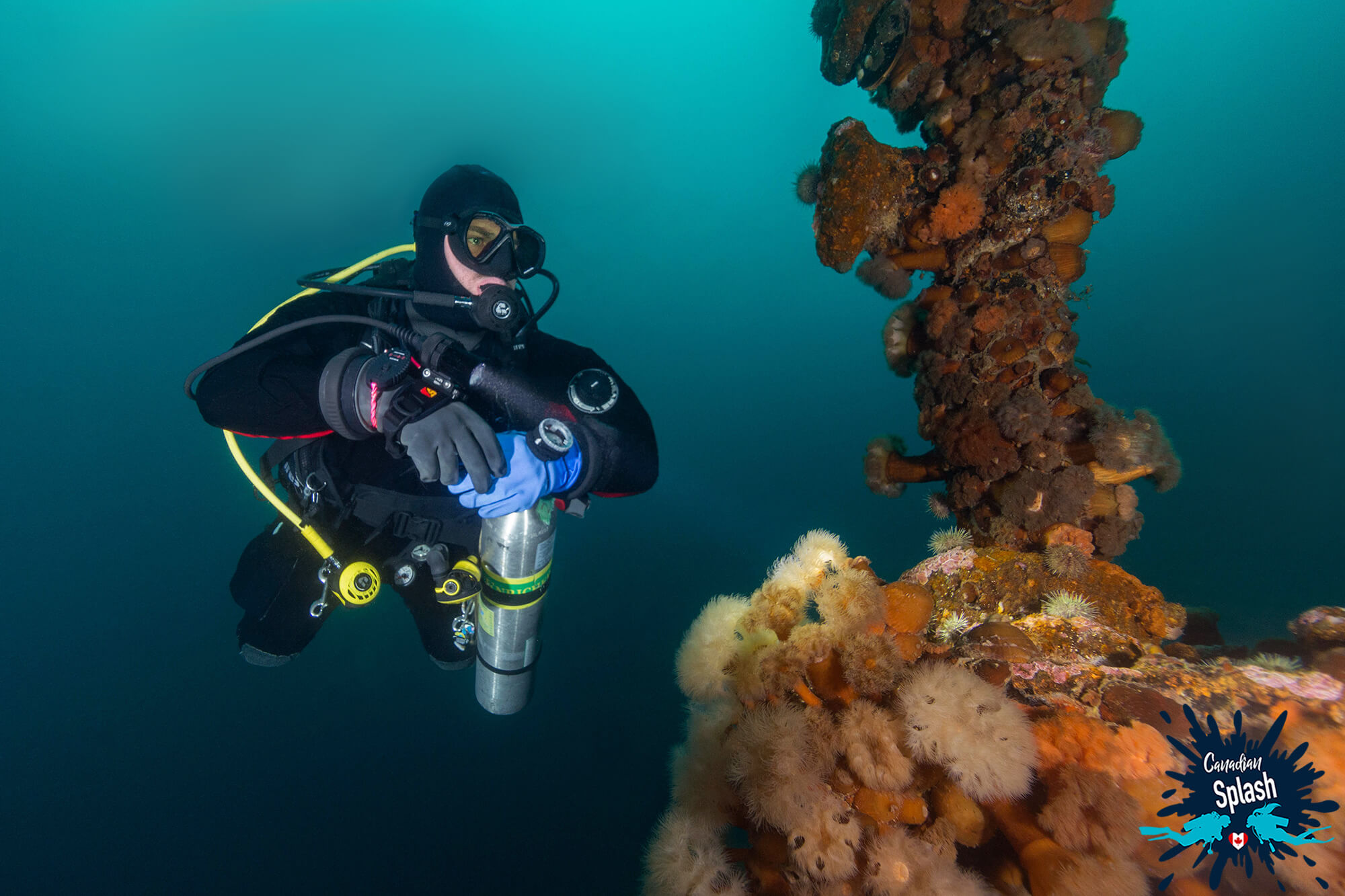
Joey loved patrolling the ship and finding the enormous anchor which had flung out of the water and crashed down on deck during the sinking.
In our opinion, the Saganaga had some of the best photography opportunities of the trip. We spent most of our time between 18 and 26 meters (60 and 85 feet) where the stairs, structure, and anemones were most impressive.

Things went much smoother on our second dive day, which is as to be expected as we familiarized ourselves with the diving procedures. The Lord Strathcona and a second dive to the Saganaga were slotted on the dive schedule.
The Lord Strathcona is the second deepest of the four Bell Island shipwrecks and a sister ship to the, not yet dove, SS Rose Castle.
Like the previous day, we took to the biting cold water, excited to see what underwater Bell Island had in store for us. As we descended the line, ctenophores danced in the water around us. Their translucent alien-looking bodies glittered in the sunlight and made it seem like they’d dropped straight from outer space.
Touching down on the marine covered deck, Joey and I could easily see that the Strathcona was in much better condition than the PLM-27 and Saganaga. Thanks to the deeper depth, sheltering it from currents and passing icebergs, the Strathcona’s superstructure was magnificent.
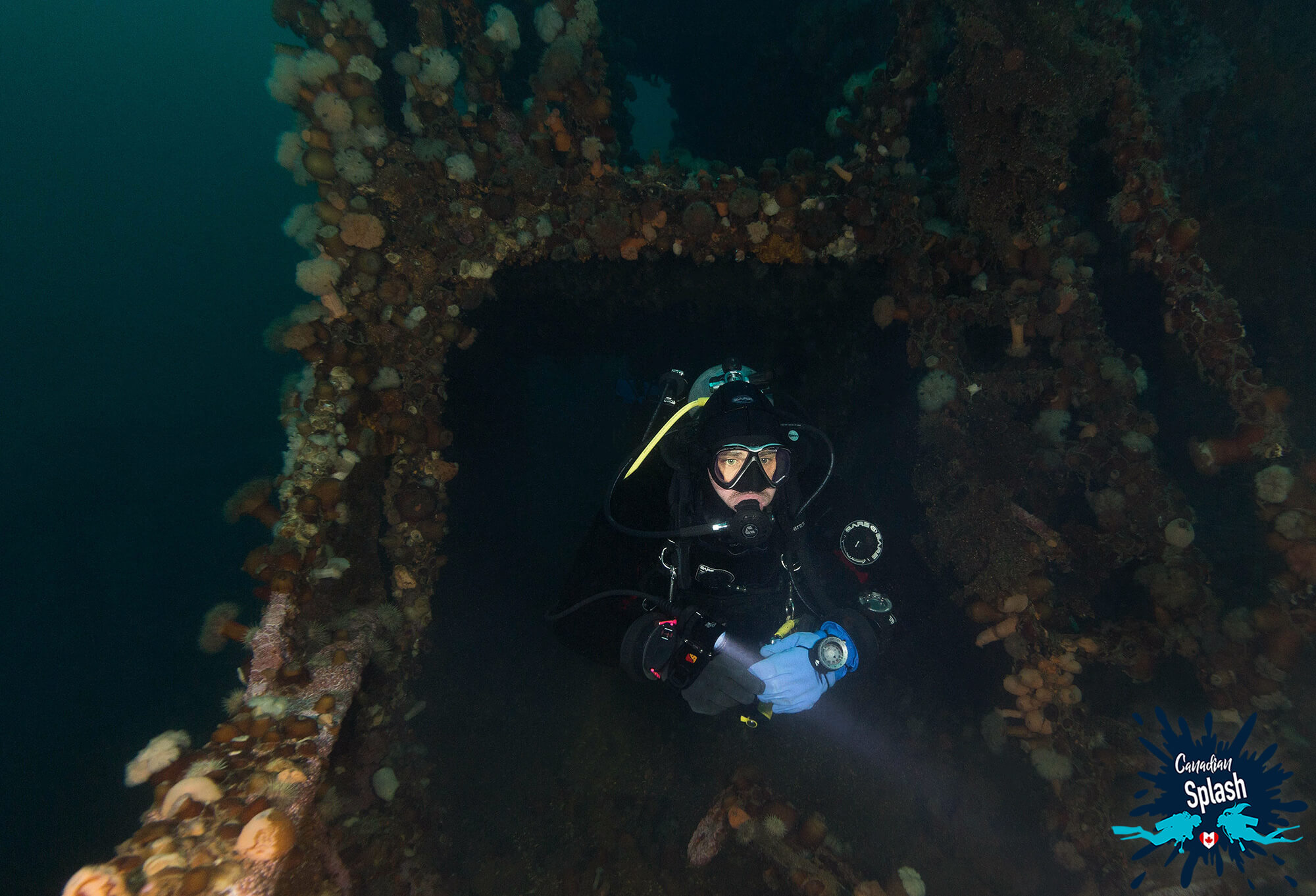
There were casual swim-throughs, long dark underwater hallways, sunken knick-knacks, and jaw-dropping photo ops. And I’m not even kidding when I say EVERYTHING was dripping with dainty plumose anemones.
What Joey and I loved even more than the towering superstructure of the ship (and it was a hard choice), was the big ol’ male lumpfish. He came out for a visit right at the bottom of the Lord Strathcona ascent line and was utterly entranced with my camera lights.
Interesting Fact: Lumpfish are usually a mixture of yellows, greys, greens, and browns, however during spawning the male lumpfish become a vivid red color as seen in the image above.
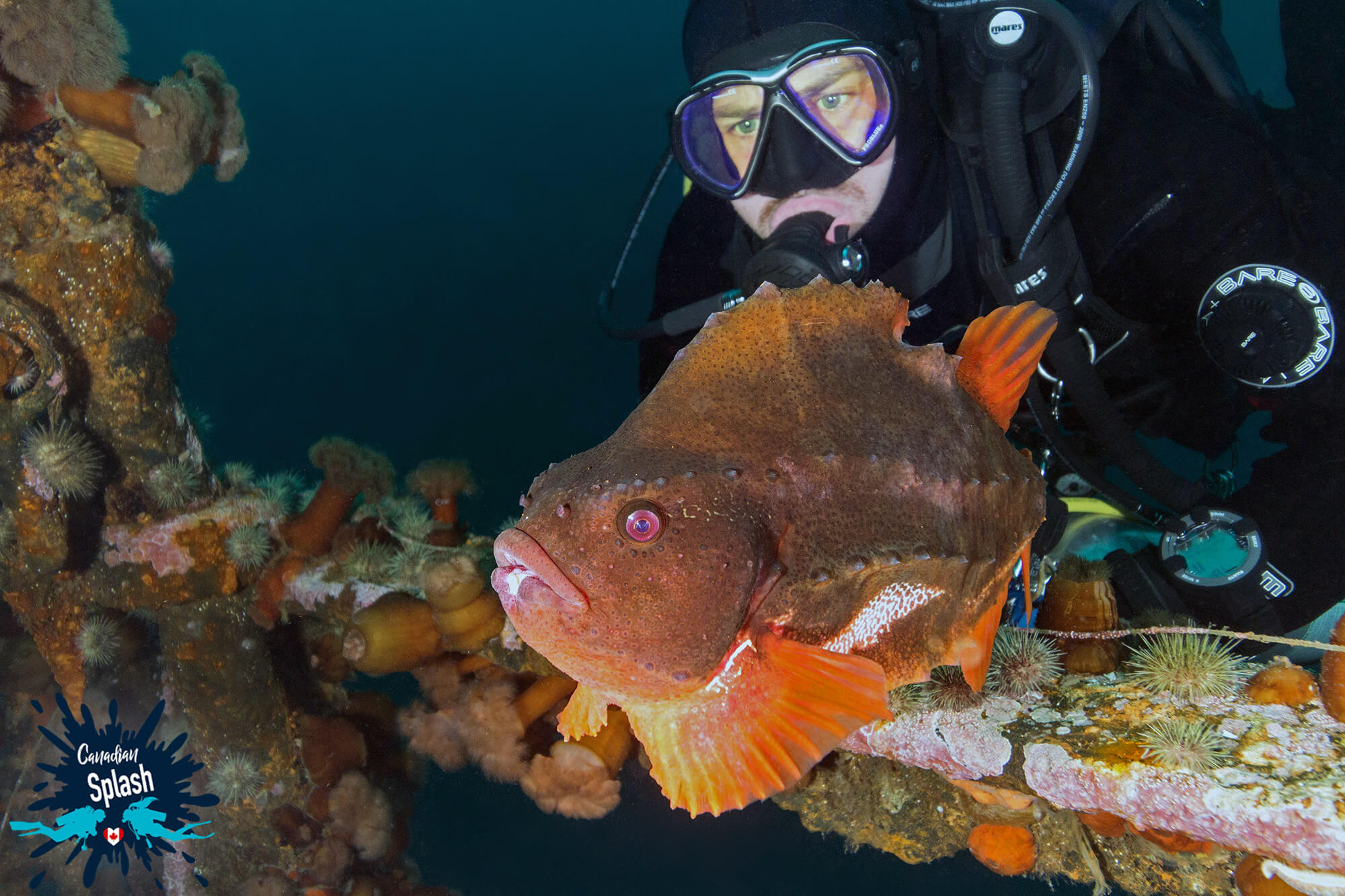
We dove the SS Rose Castle on the third day of our 5-day Newfoundland Wrecksploration adventure.
This boat is considered the crown Jewel of the Bell Island shipwrecks. Sister ship to the Lord Strathcona, the Rose Castle is the deepest of the four wrecks shipwrecks. Because of the Rose Castles depth, this vessel is in a true time capsule from back in the day. She’s in pristine condition, with rigging and artifacts aplenty located in the exact places they landed when she sank to the bottom.
Throughout our five-day Bell Island dive excursion, we dove the Rose Castle three times. In part because of limited bottom time – allowing us to only explore small sections of the ship – but also because she was just an utterly magnificent looking beast.

Anemones, fish, soft corals, and swim-throughs comprised most of what we laid eyes on while diving the Rose Castle. And below the icy thermocline, we were lucky to catch a basket star clinging to some ghost netting.
At the back of the ship, we had the luxury of enjoying a sea life encrusted stern gun. The gun protruded out into the open ocean from the boat and seemed to stand guard and protect the Rose Castle in her final watery resting place. Boys will be boys, and as you can probably tell from the picture, the stern gun was the highlight of the shipwreck for Joey. He wasted no time swimming around guns blazing.
Although we were not certified to make the visit, for technical divers, there is an intact torpedo on the seabed. The torpedo sits just off the Rose Castle shipwreck, in 50 meters (165 feet) of water requiring a decompression stop.

When you get to combine your love for history with your love for scuba diving, it’s something both meaningful and special. It’s the historic ride of a lifetime.
For most, World War II is a thing of distant memory. For Newfoundland, this memory hits closer to home. Heading underwater in Bell Island is like taking a swim into the past. The sea is rich with tales of German commanders, torpedoes and sneaky U-boat invasions.
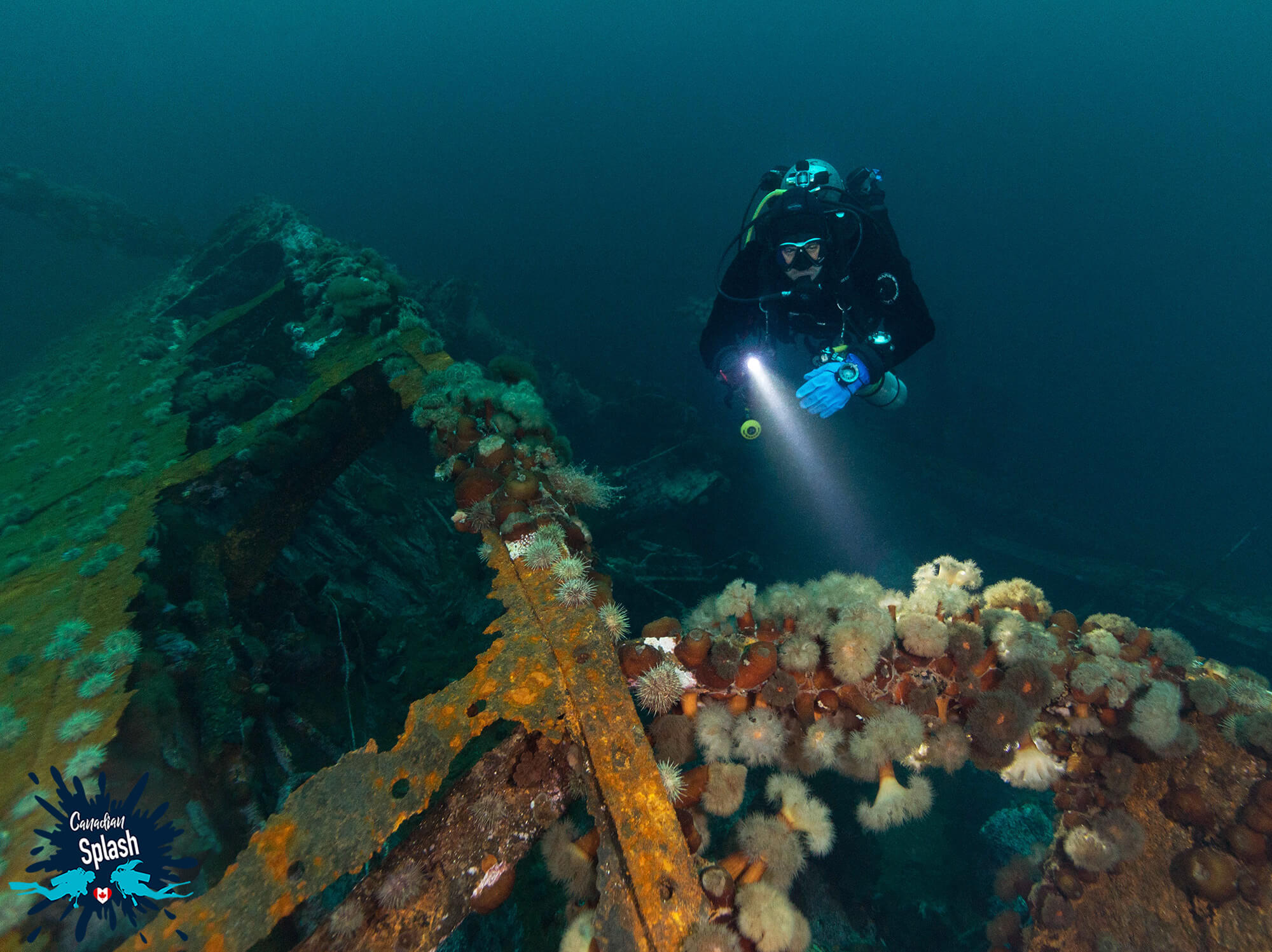
There is a reason why you hear so much about how amazing the Bell Island shipwrecks are in scuba diving books and magazines. That’s because they offer are some of the BEST cold water wrecks in the world. After our time on the island, we will rightfully attest to this claim to fame. From outrageously clear water to impressive megafauna and everything in between, Newfoundland is a Canadian diving location that delivers – no questions asked.
As a first-timer diving in Newfoundland, this province has left me speechless – and that’s saying something considering I usually have a lot to say.

Newfoundland is a cold water dive destination of dreams. What is the coolest thing you have ever seen in this province?
Writers Note: This amazing scuba diving location was featured in DAN’s Alert Diver Magazine – Newfoundland: Where History and Diving Collide as a part of the February 2020 Q1 publication.
Additionally, this post may contain affiliate links. We will make a small commission if you make a purchase through one of these links, at no extra cost to you. See full disclosure and disclaimer policy here.
Want to explore more diving in Canada’s eastern province of Newfoundland? Take a look at our Canadian Splash project to discover more underwater adventures.

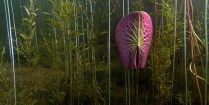
When it comes to getting outside and immersed in nature, Ontario Parks is at the top of the list. Not only do the parks boast magnificent nature, but it's hundreds of thousands of lakes make it a real treat for those who love the water.
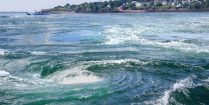
Submerging into the cold waters of Deer Island is one of the best ways to appreciate the vibrant array of color the Bay of Fundy hides beneath her surface.
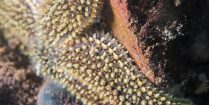
Sometimes finding a good dive spot is easier said than done. Shore diving around Saint John, New Brunswick is a testament to how unpredictable the Bay Fundy can be.
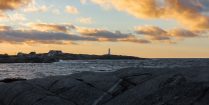
When diving in Nova Scotia where do you even begin? Do you start in Halifax the province's capital or do you wander beyond to see what the surrounding area has to offer?

Nova Scotia is full of cold water diving opportunities, particularly around shores of Halifax.

Saint Andrews by-the-sea may be small in size, but this summer town packs a pretty big dive punch for scuba divers willing to brave the Bay of Fundy's tides.
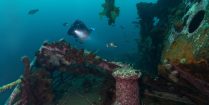
Do you enjoy cold water wreck diving? This dive destination will let you experience the best shipwrecks and scuba diving opportunities on the Canadian east coast.

Iceland may be close to the Arctic circle, but that didn't stop us from diving into the clearest water on the planet.
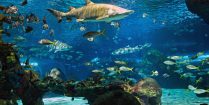
Do you want to try diving inside an aquarium? This unique Canadian location lets you experience scuba diving and up-close animal encounters like never before.
